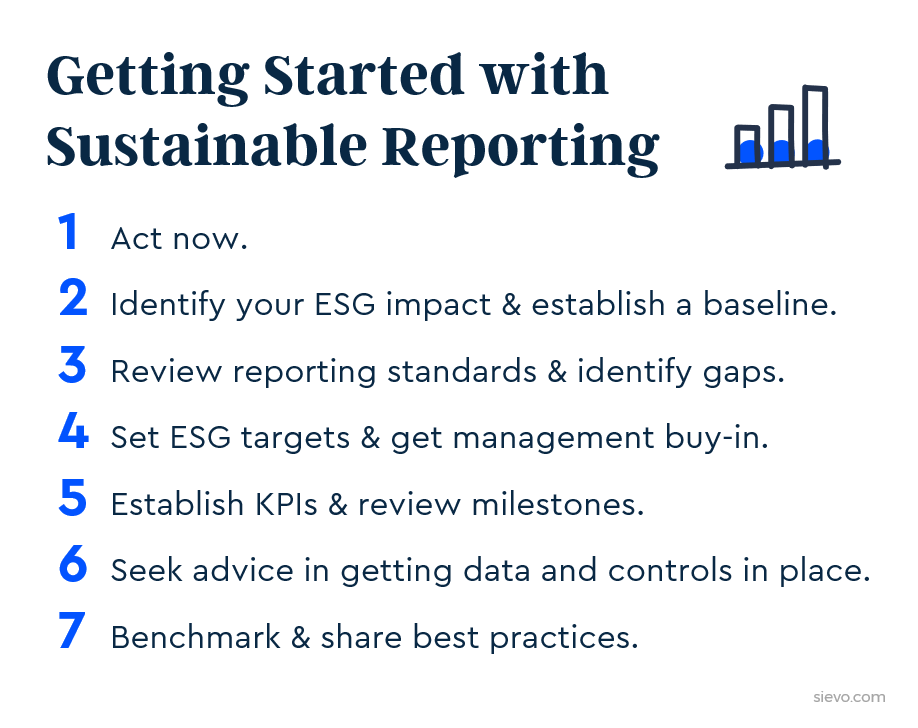Reporting on sustainability initiatives is no longer optional. Even medium-sized companies are getting stricter reporting requirements.
There are no global templates or set of rules to follow. Various sustainability standards are used. For global companies, a widely recognized standard is the Global Reporting Initiative (GRI). The GRI provides a common reporting language that helps companies compare themselves with their peers.
With the Corporate Sustainability Reporting Directive (CSRD) coming into effect in 2025, now is the time to start preparing your sustainability reporting.
This article will give you the details on what to expect and how to prepare.
Why report on sustainability?
Beyond statutory requirements, reporting on environmental, social, and governance achievements has immense benefits.
One benefit of ESG reporting is the chance to showcase positive development and the ability to set milestones.
Need to start from the beginning? Read our comprehensive guide Sustainable Procurement 101.
Good results build brand reputation and loyalty, provide access to capital, engage employees, and attract customers. Stakeholders and investors get broader insights and can assess sustainability risks and opportunities that continue to inform their decision-making outside the financial factors alone.
Longer-term strategies can be adjusted, benchmarks applied, and improvement opportunities identified for continued benefit and engagement.

The European sustainability reporting landscape
European law requires certain large companies to disclose information on how they operate and manage social and environmental challenges.
Sustainability reporting requirements aim to encourage organizations to develop a responsible approach to business.
The current Non-Financial Reporting Directive (NFRD) applies to approximately 12,000 large public-interest organizations within the EU region with more than 500 employees.
A new directive will shortly replace it with an expanded scope involving many smaller companies.
The Corporate Sustainability Reporting Directive (CSRD)
The CSRD is being phased in over two years, starting with the companies already covered by the NFRD.
From 2025 onward, EU companies must report on their performance in specified areas. These companies will have to disclose detailed and transparent information on defined sustainability issues publicly:
-
Environmental matters
-
Social matters and treatment of employees
-
Respect for human rights
-
Anti-corruption and bribery
-
Diversity on company boards
Also, they must assess the impact on their business risks and opportunities – (the outside-in perspective) and people and the environment (the inside-out perspective).
The standards are concerned with identifying all potential negative and positive impacts on people and the environment connected with a company’s operations and value chain.
What standards will you have to report?
Companies must report based on European Sustainability Reporting Standards (ESRS), which can be divided into Cross-cutting and Topical standards. Topical standards can be further divided by ESG topics.
The standards apply to themes like:
-
Greenhouse gas emissions (GHG Protocol)
-
Energy efficiency
-
Environmental footprint results (Life Cycle Assessments) and dependencies
-
Social responsibility (e.g., working conditions, human rights, equal opportunities)
-
All sustainability/ESG issues affecting the company’s financial health and operational performance.
-
The methodology used to ensure information is of high quality
Standards also consider alignment and consistency between EU reporting standards and public policy agreements, goals, frameworks, and regulations.
You can find more details here on timing and including more organizations in CSRD.
When will CSRD apply to me?
From January 1, 2026, small—to medium-sized companies with securities listed on regulated markets must start reporting according to CSRD.
However, the listed SMEs will have simpler standards for reporting than large companies.
Non-listed SMEs can choose to use the CSRD’s reporting standards voluntarily to promote transparency and commitment to sustainable business practices.
How will CSRD affect your organization?
The directive on sustainability reporting indicates that a robust, transparent, verifiable, and auditable reporting system will be needed.
The environmental requirements cover various categories, including measuring and reporting greenhouse gas emissions (Scope 1, 2, and 3 emissions).
The reporting requirements also include measuring water resources and pollution, energy use, and climate change mitigation strategies. Eventually, this means tracking the entire environmental footprint of your business operations.
"Investors and stakeholders demand a much wider range of information about a company’s approach to governance, risk management, and strategic planning. Pursuing short-term profitability at the expense of creating sustainable, long-term value is no longer an option." - Deloitte, 2021
How can I prepare for CSRD?
-
Start now! Secure top-level commitment and sufficient resources and capabilities for the challenge at hand.
-
Identify your current environmental, economic, and social impact and establish a baseline for reporting.
-
Review and assess the proposed CSRD reporting standards and align them with your preparation. Identify potential gaps and gather the necessary information to be compliant.
-
Set environmental, social, and governance targets and approve them at the senior level. Communicate targets to your stakeholders.
-
Establish Sustainability KPIs to monitor at your next review and milestones.
-
Welcome professional advice and support on how to get the required data, processes, and controls in place.
-
Benchmark and share best practices with your peers.

Getting compliant with analytics
Collating, cleansing, and categorizing sustainability data is a huge task that cannot be achieved manually. Sustainability data required to form the “big picture” lives in various locations, forms, and data sets.
Cloud-based analytical solutions can identify data sources, automate the collection of raw data, and turn it into usable information for reporting and insights. Having a single source of truth for your sustainability data enables diving deep into function and category level and following up the progress.
To comply with the reporting requirements, you must trust that your data is accurate, timely, and high quality. Sievo CO2 Analytics gives visibility into scope 3 emissions data. Our solution has been audited by a third party.
Header photo credit: @florianwehde (Unsplash.com)




